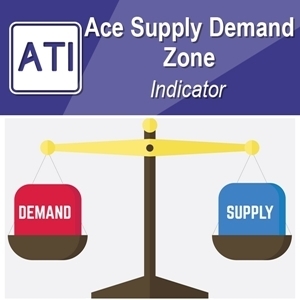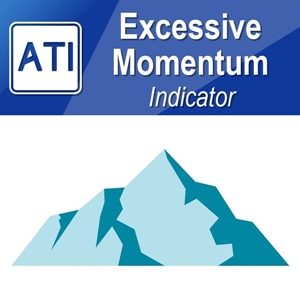Turning Point Prediction for Forex
In Forex trading, turning point prediction is a technique used to identify the time when a currency pair’s trend starts to change in an important way. There are several methods for predicting turning points, including technical analysis, statistical prediction, artificial intelligence, and fractal pattern. In this article, we will explain the hybrid turning point prediction method combined with technical analysis, statistical prediction and fractal pattern. There could be some technical terms in this article. We will highlight the meaning of the important technical terms before we go on to the main text to help you to understand better with this topic.
- Turning Point: a turning point is a price level in which the market can change its direction from bearish to bullish or from bullish to bearish. In fact, the turning point can be considered as the peak and trough in cycle. To visualize it, just consider a simple cycle like a sine curve or cosine curve ranging betweeen 1 and -1 in y axis. Then you can mark the peak at 1 and you can mark the trough at -1 in the curve.
- Stochastic cycle: Turning point becomes a powerful weapon when you understand the market cycle in Forex and Stock market. However the market cycle is not like a simple cycle like a sine curve or cosine curve. Instead, the market cycle is the stochastic cycle. For example, a sine curve is a determininstic cycle, whose cycle period is fixed. In stochastic cycle, the cycle period is not fixed but probablistic meaning that the cycle period can be alternating around the mean or average. The harder part is that, there are multiple of stochastic cycles in the market cycle of Forex and Stock market.
- Fractal Wave: Fractal wave is one tool that can study or predict all the stochastic cycles present in the market in both using statistical and non statistical methods. Fractal wave is simple and effective method proven for many decades along with the evolution of the financial market since Bernoit Mandelbrot dedicated most of his life to the study of fractals, as well as the mathematics of roughness and self-similarity.
- Fractal Wave for Non statistical method: Fibonacci trading, Support and resistance trading, Harmonic Pattern, Elliott Wave pattern and X3 Chart Pattern can be considered as the chart pattern analysis using the Fractal Wave concept.
- Fractal Wave for statistical method: Firstly, Fractal Wave theory can be used to perform the Fractal Decomposition technique to extract each market cycle (=stochastic cycle) in Forex and Stock market. Secondly, once the Fractal Decomposition is done, one can visualize each stochastic cycle using Fractal Cycle Analysis.
- Turning Point Probability: turning point probability is the probability measured in each stochastic cycle extracted and visualized in the Fractal Cycle Analysis to indicate the potential turning point to make a buy or sell decision. Just like other probability, the turning point probability ranges between 0 and 1 or between 0% and 100%.
- Trend Probability: Although there are many ways to calcualte the trend probability, one can simply calculate the trend probabilty in the Stochastic cycle uisng this simple equation: “the trend probability = 1.0 – the turning point probability”.
1. Turning Point Probability in Price and Time
A stochastic cycle means that there is no fixed wavelength and fixed amplitude whereas we can observe wavelength and amplitude fixed in deterministic cycle. However, there are also some shared characteristics between stochastic cycle and deterministic cycle too. For example, both cycles are made up from alternating peaks and troughs. For example, trough must come after peak and peak must come after trough. It should do the same in sine wave and fractal wave. In any case, if data presents wave order like peak – peak – trough or trough – trough – peak, then they are not the right data to model stochastic cycles.
In deterministic cycle, we can tell when next peak and next trough will arrive based on their amplitude and wavelength. In stochastic cycle, we can only tell if current swing low can become the bullish turning point with probability based on the size of amplitude and wavelength. In trading, this swing low provides the opportunity of turning point for bullish market. Hence, we can call this as turning point probability. If the turning point probability is measured using wavelength, then the turning point probability represents the reversal probability in time dimension. If the turning point probability is measured using amplitude, then the turning point probability represent the reversal probability in price dimension. Trading is all about managing uncertainty. In our trading, this is useful because we can tell the uncertainty associated with making buy entry at current swing low. If uncertainty is high, then we can simply avoid. This is best way to save your money but grow your capital.
Since probability involved, some might concern the complexity of trading operation. No not at all. Simply speaking, just bear this in mind that the turning point probability in price increases if the size of amplitude increases too. In the case of price, the size of amplitude is equivalent to the height measured between swing high and swing low. Likewise, the turning point probability in time increases if current wavelength increases too. In another words, when market moves in the same direction for prolonged period, then the chance for reversal is high. This is probably common sense being far from rocket science. We would expect some bullish reversal if market makes bearish move with sudden extreme volatility. Likewise, if market was moving in bearish direction for prolonged period, then the chance of having bullish market is increasing.
What is different now and then? Before we introduce Fractal Cycle Analysis, this opportunity was ignored or less understood because the ruler of measuring prolonged period and extreme amplitude of fractal wave was not available. Especially, there are not many people using the time duration as part of their trading strategy. Now we can tell that time is actually very important variable in our trading strategy. Assuming that when there is no other analysis involved in your trading, typically it is safer to make entry with higher turning point probability in price and time. This opens up the approach of statistical arbitrage. Since statistical arbitrage involves intensive statistical knowledge, we will not cover them in this book. One thing you should remember is that joint probability between cycles should be not ignored in the statistical arbitrage trading. In this chapter, we have explained how to access the statistical regularity present in fractal wave in the financial market. For example, turning point probability and the joint probability between cycles are the important statistical knowledge applicable in financial trading. For the complete prediction, we need to combine this statistical regularity together with geometric regularity.
Geometric Prediction = statistical regularity + geometric regularity + surrounding knowledge around object
In the next part of this book, we will discuss how to make the prediction using statistical regularity and geometric regularity together. We will also demonstrate them with some practical examples.
2. Deterministic Cycle and Stochastic Cycle in Financial Market
In regards to trading strategy, we could have the in depth discussion on the topic of deterministic cycle versus stochastic cycle. Which one would be the dominating one in the financial market? In our trading, this really matters because we need to apply the right strategy in our trading. When we apply wrong strategy in our trading, we have to pay an expensive penalty from our pocket. So what is the right answer on this question? Fortunately, at least, one side is straight forward, for example, deterministic cycle. Because we know the property of deterministic cycles well. The main characteristic of the deterministic cycle is that they repeat like sine curve. Yes, there is another type of deterministic cycle like seasonality. Curvature might look different from sine curve, but you will see that some portion of data is repeating in the fixed time duration, also known as period. This sort of regularity is noticeable. Now some might argue that in practice several cycles can be combined making it harder to find the cycles. Yes, it is true. For example, in electricity and natural gas demand time series, we can observe the combined deterministic cycles in hourly, weekly, and yearly period.
What about in the financial price series, which behaves completely different from gas and electricity demand series? If there are several deterministic cycles, it should be noticeable with many explorative tools such as Periodogram, Seasonalogram, ACF, PCAF and so on. If they do that, it would open up the arbitrage opportunity like profiting from buying stocks on summer and selling them winter, for example. The truth is often it is not possible. We know that this is not the great idea to trade stock. For example, we do not see many traders who buy stocks in summer and sell stocks in winter or the other way around. In addition, we do not see many traders who buy stocks on Monday and sell them on Friday regularly. Yes, it is not a good idea. I understand that there are some literatures reporting the seasonality in the S&P 500 monthly price series. I do not deny on this because monthly time series is often out of interest for many day trader and swing trader. In addition, the literature also reports the weak seasonality instead of strong seasonality.
In regards to the weak seasonality in some financial price series, we have to accept the fact that some data might possess the cyclic property in between deterministic cycle and stochastic cycle. In such a case, model-fitting error between the prediction and the actual might be low enough to consider it as valid model but with the confirmation of weak seasonality probably. However, in such case, modelling the data with stochastic cycle would be valid too. Therefore, when you are not sure about deterministic cycle, then it is safer to use the tool for stochastic cycles. If you want to be sure about the deterministic cycles, then it is better to confirm the presence of cycle with any of these explorative tools such as Periodogram, Seasonalogram, ACF, PCAF and so on. If you cannot confirm it with these explorative tools, it is much better to model the data with stochastic cycle. In fact, it is often safer to assume stochastic cycles in the financial market than deterministic cycles. You should model it with stochastic cycle because modelling of stochastic cycle will confirm any deterministic cycles if they exist. For example, fractal wave can model multiple deterministic cycles too because sine curve is the simple form of fractal wave anyway.
3. Singular Spectrum Analysis (SSA) and Fractal Cycle Analysis (FCA)
In order to model stochastic cycle, we need to map the price series into geometric space. This can be done using Peak Trough transform. In theory, we could perform cycle analysis on several different ways. For example, we can model the largest fractal wave first. Then we can break down the largest cycle to smaller cycle. We can continue this process until we have reasonably smaller cycle. This is the top down approach. On the other hands, we can start to model extremely smaller cycle first. Then, we can combine several small cycles to form the bigger cycle. We can continue until we have the largest fractal cycle. This is the bottom up approach. This sort of Fractal Decomposition analysis is considered as Fractal Cycle Analysis (FCA). Fractal Cycle Analysis is the stepwise refinement of the Fractal Decomposition analysis for the purpose of your application. In the application of the financial trading, the stepwise refinement can be done to catch both micro and macro movement of the market.
To aid your understanding, we will bring the counterpart example in the case of deterministic cycles because it is easier to visualize the concept this way. For example, in many ways, the Fractal Cycle Analysis (FCA) resembles the Singular Spectrum Analysis (SSA), which models deterministic cycles in time series. For example, both FCA and SSA are designed to model the cycles in multiple scales. FCA model stochastic cycles whereas SSA model deterministic cycles in the data. In Singular Spectrum Analysis, the eigenvector relates the structure of deterministic cycles in different scales. However, when we model stochastic cycles, we cannot apply the deterministic relationship. Hence, we can only calculate the joint probability of the two cycles.
Presence of joint probability is hardly not surprising because we have already covered child waves inside mother wave. Simply speaking, joint probability describes the chance of both mother wave and child wave will turn at the same time. In analogically speaking, high joint probability in stochastic cycle is equivalent to the global turning point of small and large cycle in deterministic cycles. In deterministic cycle, it is easy to identify such global turning point by summing up the amplitude of small and large cycle. In stochastic cycle, even with high joint probability, we can only make statistical prediction.
4. Applying Turning Point Prediction in Real World Forex Application
Fractal Pattern Scanner provides the ability to predict the turning point in the financial market. In this article, we provide the practical guide line on how to use the provided turning point prediction for your day trading. The turning point prediction consists of two prediction types. The first one is the prediction of trough. In the trough prediction, we are trying to predict the possible bullish turning point while the price is falling. The second one is the prediction of Peak. In peak prediction, we are trying to predict the possible bearish turning point while the price is rising. The turning point prediction is useful because it tells us the complete story of the price series. For example, it will provide you the visual guidance of price movement + it will also provides the probability information. It is a true hybrid of statistical prediction and technical analysis. As a trader, we can manage the entry and exit with the turning point prediction. Another advantage is that the probability provides us the opportunity for the second level of decision making. This is in fact the important part because many other technical indicator miss to provide the probability information, which we can use for the more advanced level of decision making. With ability to read these probability, practically we can use these turning point prediction to decide the price action in the financial market. They are the good predictor of the price movement assuming you are not misusing the probability information.
Here are the breakdown of the price action with the turning point prediction. We also provide the screenshot to explain each peak and trough cases with some visual aid. As you can see from the screenshot, we can respectively draw two price action for each peak and trough prediction.
When We Predict the Peak:
1. Possible bullish breakout trading opportunity at low probability area
2. Possible bearish reversal trading opportunity at high probability area
When We Predict the Trough:
1. Possible bearish breakout trading opportunity at low probability area
2. Possible bullish reversal trading opportunity at high probability area.
Probably, guessing of these price actions is so natural during the turning point prediction. The screenshot below is for you to confirm your understanding. If the term of peak and trough is not familiar to you, then google some physics articles explaining Peak and Trough in wave cycle. We are using the identical term here as we do not want to reinvent the wheel again. Once, you understand the cycle with peak and trough in those articles, it would be much easier to project the action items for your trading with this article too. In my opinion, the turning point prediction is in its unique position between the statistical prediction and technical analysis. Probably we can consider it as the hybrid of both world. We will recommend you enjoying this scientific advancement for your trading.
For example, you can watch this video titled as “Breakout Trading vs Reversal Trading – Turn Support & Resistance to Killer Strategy” to understand how to control the market timing with this probability tool.
YouTube: https://www.youtube.com/watch?v=UbORmOacKIQ
Below is the landing page for Fractal Pattern Scanner in MetaTrader version.
https://www.mql5.com/en/market/product/49170
https://www.mql5.com/en/market/product/49169
https://algotrading-investment.com/portfolio-item/fractal-pattern-scanner/
Related Products






